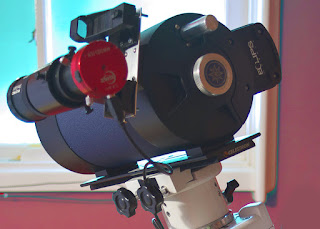What's this bolt do? Saving your scope from disaster.
Most high-end mounts attach to the telescope using a dovetail clamp. The telescope itself has a dovetail bar on it, which has a trapezium cross-section. This normally bolts to tube rings, which encircle the tube so they don't crimp it in any one spot, but some light tubes bolt directly to the dovetail.
All you have to do is open the clamp on the mount, slide the telescope in so the clamp goes over the dovetail, and wind the clamp shut. Simple.
The main advantage of having a clamp is that it keeps your scope parallel with the RA axis on the mount. It also doesn't scratch your dovetail bar.
But are there disadvantages?
I certainly never thought so. However, last time I was up at the dark sky site I was talking with far better astronomer than I, past ASV president, and general all-round good guy Russell Cockman. Russell was looking at my rig and brought up the subject of dovetail clamps. He asked me if I was scared of using one.
This is my previous scope sitting on its mount. The dovetail is the plate in between them, and it's bolted to the scope. If you undo the black knobs on the mount saddle, it opens the clamp and the dovetail either slides out or lifts out, if you open the clamp even further.Really? Why should I be scared of using a dovetail? I felt like Jim Hacker when Sir Humphrey told him his decision was "brave".
Then Russell told me a story - a cautionary tale - about clamps and temperature. Let's say you're setting up your equipment at the dark sky site. The weather is beautiful and sunny - after all, that's why you're here. You carefully set up your mount on the pier provided by the ASV (lesser beings use a tripod), attach the counterweights and then put your pride and joy on the mount, tightening the clamps as you always do. Then you wrap your scope in a reflective blanket and wait for the sun to set. Maybe you go to the pub.
While you're at the pub, physics happens.
The sun shines at an increasingly low angle. It shines on your expensive refractor (or if you've got OCD, your Ritchey-Chrétien truss reflector), but the silver blanket you've wrapped around it does its job, and the OTA stays nice and cool.
Not so the mount. It's in the sun, getting warmer and warmer. The saddle gets warmer, and the clamp gets warmer.
What does metal do when it gets warmer? It expands.
Inevitably, the clamp gets beyond the point when it can hold the dovetail on your pride and joy. Gravity takes over, and your dovetail slips backwards off the mount. You get back from the pub to find your scope in pieces on the ground, slightly north of the pier.
I scoffed. That wouldn't happen. Would it? It played on my mind.When I got home, I found a bolt that fit into a convenient threaded hole in the bottom of my front tube ring. I threaded it in as deep as it would go, attached a washer and a locking nut and made sure it wasn't gong to interfere with the storage box I had built for the scope. I also had a guess at what would happen if the clamp gave way.
As far as I can tell, in the worst case scenario, the dovetail will slide backwards until the protruding bolt crashes into the casting on the saddle on the non-clamped side. I expect it will take a chip out of the powder coating on the saddle and bend the bolt, but I think that's as far as it would go.
My telescope is safe... probably.
Let's call it 10 cents worth of insurance.


Comments
Post a Comment